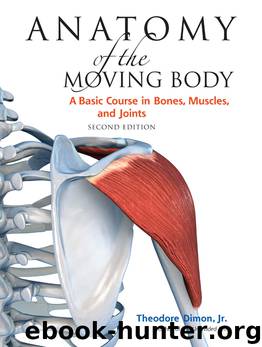Anatomy of the Moving Body by Theodore Dimon Jr

Author:Theodore Dimon, Jr. [Dimon, Theodore]
Language: eng
Format: epub
ISBN: 978-1-58394-687-9
Publisher: North Atlantic Books
Published: 2012-11-05T16:00:00+00:00
Figure 37: Ribs during exhalation and inhalation (Illustration 17.2)
When the muscles of the trunk are functioning properly, the ribs are able to move flexibly, but because of tension and postural distortion, they are typically fixed and quite rigid. When this happens, the entire thorax moves too much as a whole, and the diaphragm, the other main agent of breathing, becomes overworked to make up for the lack of movement in the ribs. Also, the rib cage as a whole becomes fixed in a wrong attitude, usually somewhat thrown backward and shortened in front and then held up, narrowing the back and preventing the free action and mobility of the ribs in breathing, as well as interfering with the general upright support of the trunk. When we are properly supported by the postural muscles and are not shortened in stature, this tends to re-orient the entire rib cage, which in turn allows a widening of the back and an increased mobility and action of the ribs.
There are two layers of rib, or intercostal, muscles which are responsible for breathing (Fig. 38). The external intercostals arise from the lower border of each rib and attach to the upper border of the rib below, running obliquely down and forward. Underneath this layer are the internal intercostals, which arise from the inner surface of each rib and slant down and back, in the opposite direction to the external intercostals, to attach to the rib below. The external intercostals function mainly to elevate the ribs, which increases the width of the thoracic cavity and therefore causes inspiration. The internal intercostals depress the ribs when actively breathing out.
Transversus thoracis lies on the inner surface of the lower part of the sternum (Fig. 39). Its fibers extend up and out, like the splayed fingers of a hand, and insert into the costal cartilages of the second, third, fourth, fifth, and sixth ribs. This muscle, which aids in forceful expiration, is the muscle that you can sometimes feel gripping in the inner chest; it contributes to the rigidity of the chest in many people who raise and fix the chest in speech and breathing.
Download
This site does not store any files on its server. We only index and link to content provided by other sites. Please contact the content providers to delete copyright contents if any and email us, we'll remove relevant links or contents immediately.
| Anatomy | Bacteriology |
| Biochemistry | Biostatistics |
| Biotechnology | Cell Biology |
| Embryology | Epidemiology |
| Genetics | Histology |
| Immunology | Microbiology |
| Neuroanatomy | Nosology |
| Pathophysiology | Physiology |
| Virology |
Tuesdays with Morrie by Mitch Albom(3842)
Yoga Anatomy by Kaminoff Leslie(3713)
Science and Development of Muscle Hypertrophy by Brad Schoenfeld(3585)
Bodyweight Strength Training: 12 Weeks to Build Muscle and Burn Fat by Jay Cardiello(3362)
Introduction to Kinesiology by Shirl J. Hoffman(3307)
How Music Works by David Byrne(2537)
Sapiens and Homo Deus by Yuval Noah Harari(2423)
Coroner's Journal by Louis Cataldie(2108)
Insomniac City by Bill Hayes(2088)
The Plant Paradox by Dr. Steven R. Gundry M.D(2052)
Churchill by Paul Johnson(2018)
Hashimoto's Protocol by Izabella Wentz PharmD(1902)
The Chimp Paradox by Peters Dr Steve(1869)
The Universe Inside You by Brian Clegg(1814)
The Immune System Recovery Plan by Susan Blum(1700)
Don't Look Behind You by Lois Duncan(1668)
The Hot Zone by Richard Preston(1640)
Endure by Alex Hutchinson(1613)
Woman: An Intimate Geography by Natalie Angier(1587)
